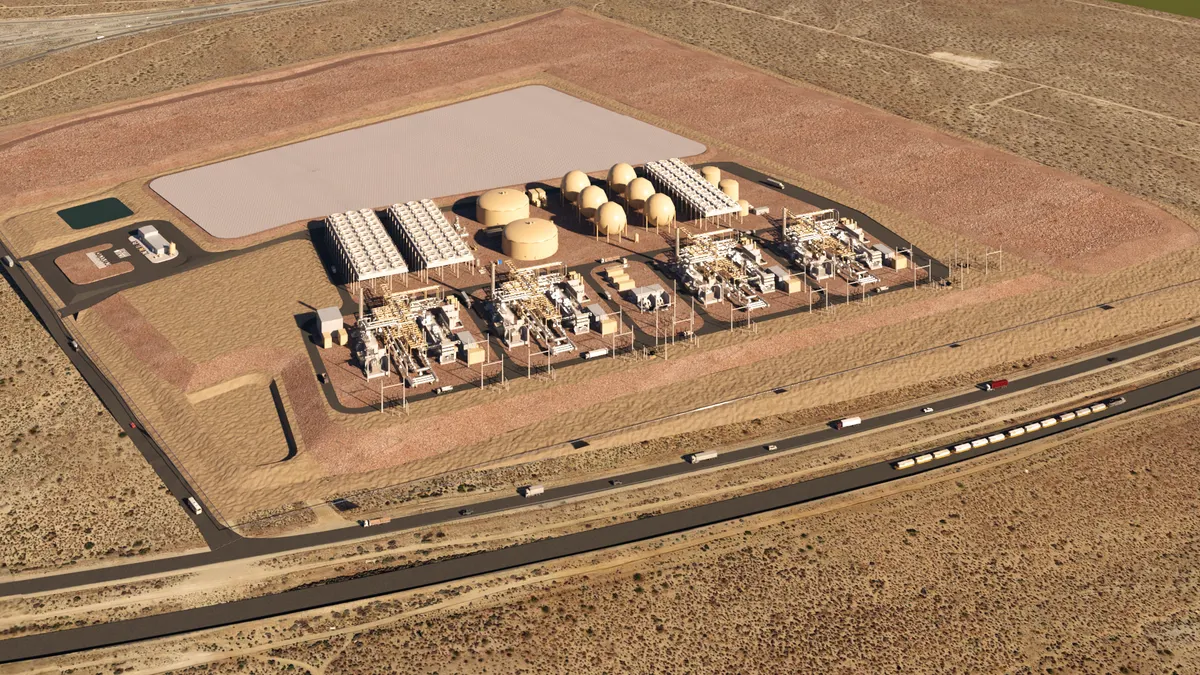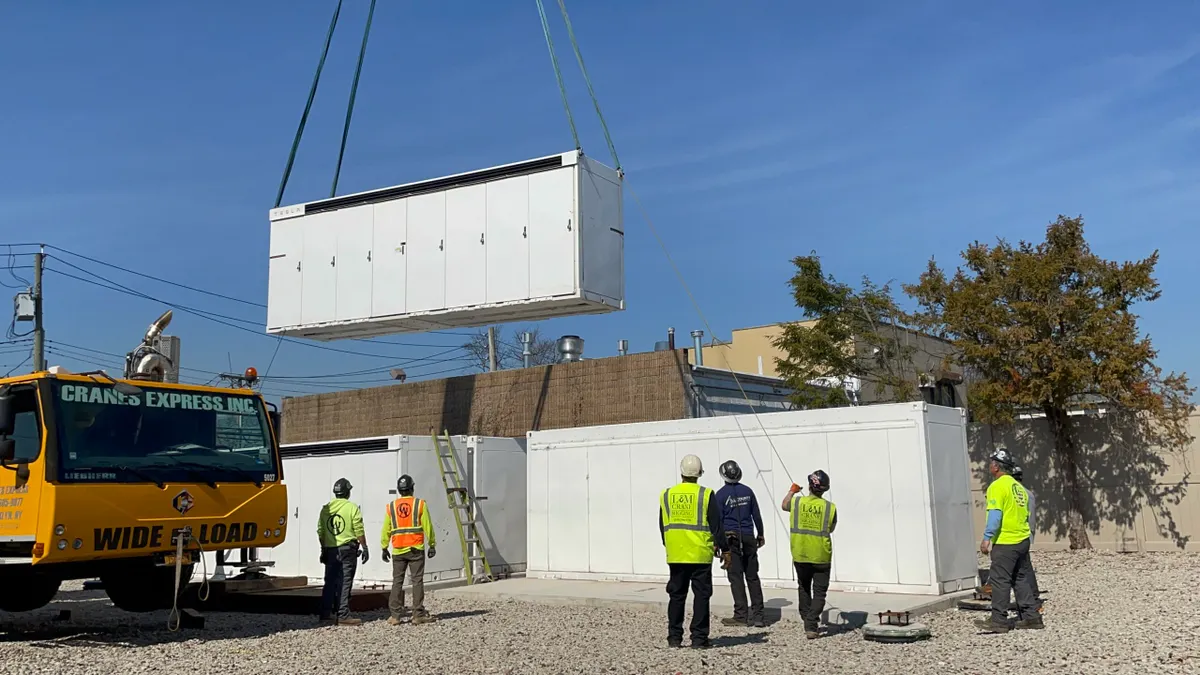For the past 10 to 15 years, electric vehicles (EV) have been the driving force behind the falling costs of lithium-ion (li-ion) batteries. But the markets for EV and stationary storage batteries are beginning to diverge, which could result in separate cost trajectories and changes in their respective supply chains.
Analysts say that about 90% of the market for stationary energy storage is served by li-ion batteries. Most of those batteries have been the same as those used in EVs because the performance metrics required for both applications are compatible, but that is changing.
"We expect that this split is already occurring due to high cobalt prices, and the move to increase EV ranges in China," James Frith, energy storage analyst at Bloomberg New Energy Finance, told Utility Dive via email. "The impact on the market isn't clear yet but it is likely to mean that manufacturers will have to make a clear decision on which market or markets they want to serve."
Going the distance: EV range priorities
EV manufacturers are moving to batteries with higher energy densities in order extend the range of their electric cars. Tesla, for instance, recently said the battery cells in its Model 3 car are the highest energy density cells in any EV.
In the company's first quarter 2018 earnings update, Tesla CEO Elon Musk said the company had moved to higher density batteries while reducing the cobalt content of its battery packs. And in June, Musk told shareholders his company would continue to push battery costs down, breaking through the $100/kWh barrier for li-ion cells later this year.
Frith said Musk's boast is "a realistic prospect," enabled by the new 21700 cell design and the use of advanced cell chemistry with much lower cobalt levels. Frith estimated that the cells used in a Tesla Model 3 cost $112/kWh.
Not all analysts were as optimistic. "We're unsure $100/kWh is achievable this year," GTM Research Analyst Mitalee Gupta told Utility Dive in June.
It's all about the chemistry, Heisenberg
Battery chemistry is at the center of declining battery costs. NCA li-ion batteries typically use a combination of 80% nickel, 15% cobalt and 5% aluminum.
Tesla has begun using a more advanced form of NCA batteries, so-called NCA+ batteries, and has managed to reduce its cobalt levels by 59% compared with the cobalt levels of its first cars, according to Frith. The company says the cobalt levels of its batteries are already lower than the next generation of batteries that will be made by other producers.
Musk says Tesla is moving to take the cobalt content of its batteries to "almost nothing." Panasonic, Tesla's main battery supplier, is also moving in that direction, as are many other battery makers.
"Peaking is where the action is going to be."

Paul Denholm
Principal Energy Analyst, National Renewable Energy Laboratory
Chinese batterymaker BYD has adopted lower energy density Lithium-Iron-Phosphate (LFP) chemistry. Lithium-manganese-oxide (LMO) chemistry also doesn't need cobalt.
But there are trade-offs. When the cobalt content of a battery is reduced, it reduces the number of times a battery can be cycled, according to Frith. In addition, the race toward higher density EV batteries also comes with drawbacks. Higher density batteries require more cooling and even then, there is a trade-off with cycling. Higher density batteries are unlikely to provide the 2,000-plus cycles required for stationary applications, Frith said. Reducing cycle life is less of an issue for EVs than it is for stationary storage.
As EVs move towards newer nickel-manganese-cobalt (NMC) chemistries, such as NMC (811), Frith expects developers of stationary energy storage projects to move back to LFP and LMO technologies and eventually to the new NMC chemistries such as NMC (442), which is more stable than new EV NMC chemistries but has a lower energy density. Frith says the Lithium Titanate Oxide (LTO) and LMO systems are likely to remain dominant in the stationary storage market, as well, because despite their poor energy density, they have superior cycling performance.
Code red on cobalt
Rising prices, as well as political concerns, have made cobalt, a key ingredient in battery chemistries, expensive and unpopular.
The battery industry currently uses about 42% of global cobalt production, About 60% comes from the Democratic Republic of Congo and is mined under harsh conditions that include the use of child miners, leading critics to call the metal the "blood diamond of batteries."
In addition, about 97% of cobalt supplies are produced as a byproduct of mining nickel or copper, and the prices of those metals have plunged, making many deposits uneconomic, and cobalt even more expensive. In February 2016, the metal hit a record low but then rose 129% in 2017 and reached $75,500 per ton on the London Metal Exchange by year end.
"A lot of it comes down to cobalt," Matt Keyser, senior engineer at the National Renewable Energy Laboratory (NREL), told Utility Dive. The metal is going to become less and less available because the Democratic Republic of Congo controls so much supply and it is an unstable regime, he said.
Cobalt will probably be reserved for battery applications that need high density, like cell phones, laptops and EVs. Otherwise, "why pay the price for something you don’t need," Keyser said. That will also likely mean that the cost curves for different types of batteries will diverge, but right now it is hard to say how prices might diverge, he said.
Waiting for storage market changes
The divergence that appears to be occurring between the EV and stationary battery markets is similar to the divergence that occurred in the past between batteries for consumer electronics, such as phones and laptops, and EVs, according to Christopher Robinson, an analyst with Lux Research.
When EVs were first coming to market, the industry used off-the-shelf batteries, but as the EV market developed EV makers began to use more specialized batteries.
Similarly, developers of stationary storage projects have been using large banks of EV li-ion batteries. But as stationary storage grows, there is likely to be a growing divergence between the energy density needs of the EV market and the cycling needs of the stationary market.
"We are starting to see that on the stationary side," Robinson told Utility Dive. Some factories already could have multiple production lines, he said. And as the divergence grows, it could lead to separate production lines at factories for EV and stationary batteries and it could lead to some divergence of prices.
On the other hand, if existing EV batteries are cheaper, developers will likely use them even if they are not optimized for grid applications, according to Paul Denholm, a principal energy analyst at NREL.
"It is reasonable to say we don’t know the implications of the divergence yet," Denholm told Utility Dive.
Denholm also noted that the stationary storage market is changing. Many early stationary storage applications were for frequency regulation, which overlaps somewhat with the characteristics needed for EV batteries. But the frequency regulation market is small, about 2.5 GW in total, compared with the market for peaker replacement, which is a 250 GW market and calls for longer duration batteries, Denholm said.
The peaker market requires longer duration batteries, which could be another factor driving divergence. “Peaking is where the action is going to be,” Denholm said.





















